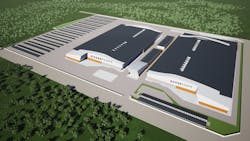Battery Manufacturing Must Take Utility-Scale Energy Storage to the Next Level
A revolutionary shift is underway in the electricity we use, and few people are even aware it’s happening. For years, much of the conversation has been about trying to get people to think green and make small changes in their lives to make a difference for the planet.
Meanwhile an idea has been taking root quietly, one with massive scale ramifications. That idea is large-scale energy storage, which has less to do with the average consumer and more to do with the decision-makers on where our energy comes from.
To understand the concept of energy storage, one must first understand the fundamental shortcomings of our electrical grid. The way the grid works sounds straightforward enough: When electricity is generated through wind, solar, or even traditional power-generation sources like coal-fired power plants, that electricity has to be pushed to the grid to be used immediately. If it goes unused, it’s essentially lost forever.
If you’ve ever driven by a wind farm and noticed that some or most of the wind turbines (Fig. 1) aren’t spinning, it’s not always because the wind isn’t blowing. Often, they aren’t spinning because the grid doesn’t need the electricity at that moment, so the wind turbines are shut down, otherwise known as curtailment.
However, energy-storage systems represent the future of utility-scale energy management, theoretically allowing every type of electricity-generation system to harvest the electricity at any time of the day and hold it in reserve for use whenever the grid actually needs it. This stands in sharp contrast to the status quo of “use it or lose it.”
But alas, nothing is that simple. While energy-storage systems have demonstrated their ability to be effective in practice, the cost far outweighs the benefit. That’s why changes in battery manufacturing, small and nuanced as they may seem, are so critical to the energy-storage sector, utilities, and most broadly, human life.
The Li-Ions
More recently, lithium-ion battery storage systems have been developed. These are capable of packing in enough energy, hopefully produced by renewables such as wind and solar at a low-enough price, to make utility-scale energy storage a practical addition for optimizing electricity-producing systems.
For industry context, the first lithium-ion batteries were commercialized for consumer use in 1991. In 2012, if you wanted a battery storage system, it would cost around $800 per kilowatt hour.
Since then, the cost of electricity from batteries has decreased 76%, and the price for standalone systems now averages about $209 per kilowatt hour. In addition to cost, today’s lithium-ion energy storage solutions (Fig. 2) also allow utilities to continuously collect and store excess energy, be it from wind and solar or traditional methods like hydro power, gas, and coal. This energy can then be used during the intermittent peak times, or when it’s needed most and the traditional grid can’t be relied upon, such as during a natural disaster or blackouts.
As amazing as these increases in energy density and decreases in production costs are, there’s still a price to pay. Nonetheless, the ability for large-scale battery storage systems to optimize electricity-generating systems is a real concept garnering mass adoption around the world, especially in parts of Australia, Europe, and Canada. The desire for more efficient and longer-lasting systems is growing, and people continue to dream of better solutions.
Developing Reliable Data and R&D
Despite the relative newness of lithium-ion batteries, they own the category, and while other battery formats offer promise, it’s lithium-ion that remains the de facto battery solution. However, in an industry this young, there’s not a lot of data about energy storage that’s easily accessible or current. So, if you happen to find data on lithium-ion battery storage, but it’s even a year or two old, the numbers for energy density and cost per kilowatt hour will be vastly different than what they are today.
Another reason why lithium-ion based energy storage is only just now beginning to hit its stride is due to the focus of previous research and development related to the technology. Electric vehicles have been the epicenter of funding and strategy for lithium-ion batteries, which is why most lithium-ion energy-storage solutions have had to make use of adapting electric-vehicle technology for energy storage. This lack of customization now opens up an opportunity for battery developers, as there’s significant room for improvement in the growing field of energy storage.
New systems now under development are specifically optimized for stationary energy storage. They’re using lithium-ion batteries and related technical components that have been designed from the ground up to be as effective as possible.
In the energy-storage sector, industry materials make up 80% of the total cost of lithium-ion battery cells. Research and development in material science for lithium-ion batteries often revolve around three key aims—lower cost, higher energy density, and longer life. For example, in terms of cost, when transitioning from NMC 5-3-2 to NMC 6-3-1, you’re looking to increase energy density with a further reduction of cobalt. With the high cost of cobalt today you could achieve as high as 5% savings in cost. This 5% savings becomes significant on a mass production scale.
On the Rise
This evolution in lithium-ion energy storage development is leading more investors, utilities, and wind and solar farm project developers to pursue these new energy-storage offerings. As new investments come in, the industry starts to develop more advanced technologies, leading to more robust supply chains (Fig. 3). In turn, the positive impacts on lithium-ion energy storage becomes more significant.
Most people are only aware of news stories related to a few kilowatts of batteries in electric cars and residential energy-storage packs. Meanwhile, there are gigawatts of lithium-ion batteries being installed to optimize our electrical grid and build an enhanced, greener, more cost-effective future. If you talk to people in areas where the grid is unreliable, or places that get hit by natural disasters and the power is sometimes out for days or weeks, they understand the importance of what we’re trying to do.
The meteoric rise of these battery systems isn’t a short-term trend. Bloomberg reports projections on adoption and growth of lithium-ion battery-storage systems are regularly being updated, and the numbers continue to grow at higher rates than previously projected.
The more we can educate people about the importance of integrating energy storage into the grid, what that means, and the impact it can have, the better off the future will be for all of us. It was only a couple of years ago that people would talk about the environmental impact of clean energy as an aspiration for the future. But we’re here to say it’s no longer a dream.
Lindsay Gorrill is CEO of KORE Power.



